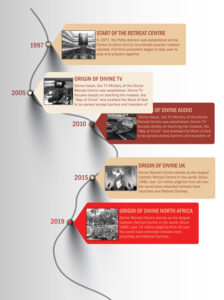Divine Retreat Centre UK – Official Website
St. Augustine of Canterbury
was a Benedictine monk who became the first Archbishop of Canterbury in the year 597. He is considered the “Apostle to the English” and a founder of the English Church.
Augustine was the prior of a monastery in Rome when Pope Gregory the Great chose him in 595 to lead a mission, usually known as the Gregorian mission, to Britain to Christianise King Æthelberht and his Kingdom of Kent from their native Anglo-Saxon paganism. Kent was probably chosen because Æthelberht had married a Christian princess, Bertha, daughter of Charibert I, the King of Paris, who was thought to exert some influence over her husband. Before reaching Kent, the missionaries had considered turning back but Gregory urged them on, and in 597 Augustine landed on the Isle of Thanet and proceeded to Æthelberht’s main town of Canterbury.
King Æthelberht converted to Christianity and allowed the missionaries to preach freely, giving them land to build a monastery outside the city walls. Augustine was consecrated as a bishop and converted many of the king’s subjects, including thousands during a mass baptism on Christmas Day in 597AD. Pope Gregory sent more missionaries in 601AD, along with encouraging letters and gifts for the churches, although attempts to persuade the native Celtic bishops to submit to Augustine’s authority failed. Roman bishops were established at London and Rochester in 604AD, and a school was founded to train Anglo-Saxon priests and missionaries. Augustine also arranged the consecration of his successor, Laurence of Canterbury. The archbishop probably died in 604AD and was soon revered as a Saint.
Origins of St Augustine’s Abbey, Ramsgate
St Augustine’s Abbey, Ramsgate was one of the Benedictine monasteries in Great Britain forming the English Province of the international Benedictine Congregation of Subiaco. The Abbey was founded as a result of the invitation made by Bishop Thomas Grant, the first Bishop of Southwark, to the Italian abbot Dom Pietro Casaretto, to send monks from St Benedict’s own monastery at Subiaco to undertake a mission at Ramsgate. By 1856 arrangements between Bishop Grant and Abbot Casaretto were concluded and the first monk, Dom Wilfrid Alcock, arrived to take charge at the Ramsgate mission which had been made possible thanks to the building of a Gothic church by the famous Gothic Revivalist architect Augustus Welby Pugin, which was donated to the Diocese of Southwark before his premature death in 1852.
In the years 1860-61, with the help of Mr Alfred Luck, a wealthy and devout benefactor, the monastery of St Augustine of Canterbury was built, the first Benedictine monastery to be built in England since the Reformation. Shortly afterwards a full monastic observance was established. The monastery gained independence from Subiaco in 1876, becoming a Priory in 1881 and was raised to the status of an Abbey by Pope Blessed Pius IX in 1896. A school was established for in 1865, which grew to provide to Catholic education for boys for well over 130 years, finally closing in 1995.
History of Divine Potta Ministries
Since 1950, the Indian Vincentian priests have been conducting parish retreats known as ‘Popular Mission Retreats’ in Kerala, India. The effect has been overwhelming – it brought out a dynamic spiritual transformation in the lives of people. There was a huge desire and inspiration for a permanent place where the people could come and attend retreats; that is how the Potta Ashram was instituted.
In 1977, the Potta Ashram was founded as the Centre to direct and to co-ordinate popular mission retreats. Full time preachers dedicated their time and stayed at the center to pray and prepare for the services. Large crowds began to flock to the ashram – the sick, the brokenhearted, and those seeking spiritual deliverance from vices including alcohol and drug addictions. God’s compassionate love poured out in abundance and healed many, as the good news of salvation flowed out to all.
In no time, Potta ashram had throngs of faithful coming in and the ashram became insufficient for the large number of people converging for week-long residential retreats held in Malayalam. A sprawling residence was acquired at Muringoor, on the banks of Chalakudy river, six km away from Potta – it was named Divine Retreat Centre. The mighty works of God spread far and wide, all over the world, and the pilgrims poured in. New vistas opened up and retreats began in six other languages – English, Konkani, Kannada, Telugu, Tamil and Hindi.
Today, Divine Retreat Centre stands as the largest Catholic Retreat Centre in the world. Since 1990, over 10 million pilgrims from all over the world have participated in retreats here. Weekly retreats in 7 languages are held non-stop every week of the year. It is truly an achievement possible only by the grace of God.
Divine TV ministry
The Vincentians were concerned about the faithful, who were touched by the Divine retreats and conventions, and had a thirst and desired for the Word of God continually being preached. Consequently, Divine Vision, the TV Ministry of the Divine Retreat Centre was conceptualized. Divine TV focuses deeply on teaching the masses, the “Way of Christ” and enabled the Word of God to be spread across barriers and boarders of churches and Retreat Centers. “In this powerful way the word of the Lord kept spreading and growing stronger (Acts 19:20).
Divine TV is the 24-hour commercial-free television channel of the Divine Vision Network (DVN). It first went on-air in UK, Europe, and the Middle East on 24 December 2008. This was quickly followed with the launch of Divine Vision Network in USA and Canada on 25 May 2009. DVN Online TV was officially launched on 4 October 2009 and is available 24/7 on the Internet.

